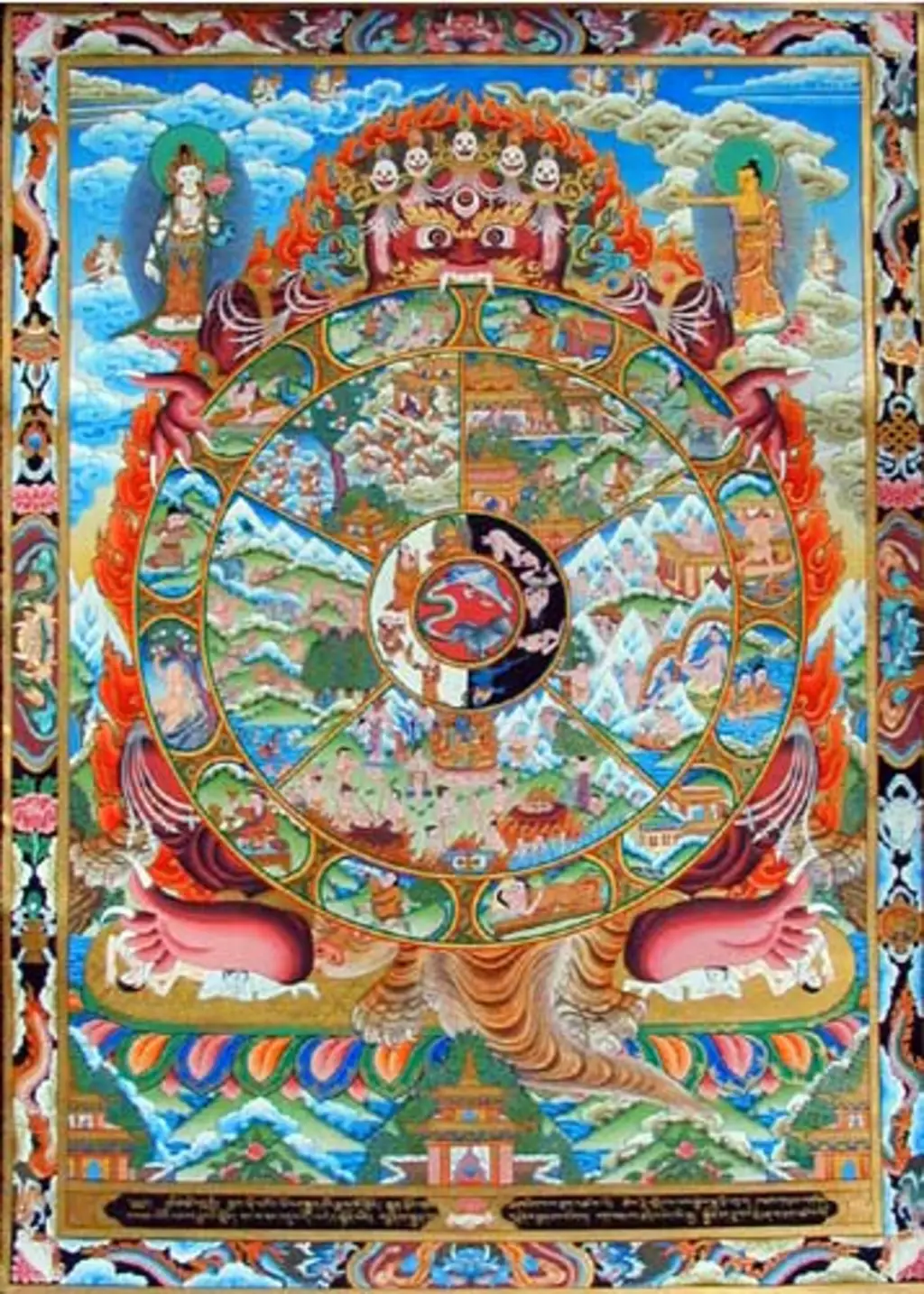Buddhism and Lists

Buddha by Numbers
Introduction
The Buddhist teachings are often organized by various lists. Various matrices of interlinked lists to organize the teachings are one of the distinctive features of Buddhism. In my studies, I find myself learning many different types of lists for memory. By doing so, I can see the benefit and how they can be expanded and interlinked. While it may seem like dry minutia and uninteresting at first glance, the lists run very deep when you start to understand how the whole system works.1 It is a complete system, and once you understand the basics, you can understand that they are all connected to each other with only a few degrees of separation.
Painting by Numbers
It is similar to painting by numbers as the picture above shows. You have an outlined form with numbers in each section. After you fill in the colors, you get a clearer and more vibrant colorful image of what was merely outlined before. The teachings were orally transmitted for the first 400 years until they were finally written down in the first century BCE. That was why the top-level discourses were brief and of a list nature. From the Four Noble Truths to six sense doors, to the five precepts and The Noble Eightfold Path, Buddhism has a list for everything and they are all interconnected. However, the lists must be expanded to fully understand the big picture.
The Four Noble Truths (list)
Let’s take a look at the two most famous lists, the Four Noble Truths, and The Eightfold Noble Path. You might have heard about this.
- The truth of suffering (dukkha sacca)
- The truth of the origin of suffering (samudaya sacca)
- The truth of the cessation of suffering (nirodha sacca)
- The truth of the path leading to the cessation of suffering (magga sacca)
The list you see above can encompass the whole of the teachings of Buddhism. However, it does need to be expanded and interlinked to live up to that statement. For instance, the first Noble Truth of suffering is quite wide. We can expand that to Saṃsāra which has 31 planes of existence that range from the deepest hells to the highest Brahma planes. That is a list. In those planes of existence, there are beings mostly with mind and matter (mind and matter are a list of 2). Mind and matter can be expanded to the Five Khandas; form, feeling, perception, mental formations, and consciousness. That can be further expanded by the Abhidhamma with 89 types of consciousness, 28 types of materiality, and 52 mental factors. I’ll spare you from the Abhidhamma lists but they are also very important and should not be overlooked, which is what most Western Buddhists do. It should be noted that dukkha is part of the triad called tilakkhaṇa, or 3 characteristics of impermanence, suffering (dukkha), and non-self. It is all of these items and many more (not listed) that relates to the First Noble Truth.
The Wheel And The Second Noble Truth
The second noble truth is often referred to as craving or desire (taṇhā) as being the cause of suffering. However, the real origin of the noble truths is referring to paṭiccasamuppāda or Dependent Origination. It is very wrong to say there is only one cause for suffering. Suffering is existing in the rounds of saṃsāra, rebirths. With dependent origination there is a list, as pictured below:


Most of you have seen the “Tibetan Wheel” before. While picturesque, you will see the word version of that wheel above. It is often called the Wheel of Saṃsāra because it explains how rebirth occurs. This wheel contains the 6 sense bases (saḷāyatana), 6 contacts (phassa), and the 3 types of feelings (vedanā). Or, since birth or life is considered suffering, it explains how that all happens. I discuss that in more detail in this article below:

Buddhism: What Happens After Death?
A long but clear and interesting religious post on what happens after death according to Classical Theravāda Buddhism.
The Third Noble Truth
The Third Noble truth is explaining that there is a way out. This is Nibbāna. While there are many different religions and terms for enlightenment, this is the real enlightenment for the Theravāda Buddhist religion. When one merely knows this truth, just for a moment, he always knows this truth. It is like knowing the Earth is round by going in a spaceship and seeing that just for a moment with your own eyes. Different classes of defilements get permanently destroyed along the way as one progresses to the last of the Four Stages of Enlightenment called Arahant.2 When an Arahant dies, there is no more rebirth and the goal has been achieved. There is nothing further, and he dies without remainder or any new creation. He does not exist or live any further than that according to Theravāda teachings. Westerners often have difficulties with that, and I explain this in my article “Does the Buddha Live In Nibbāna?”
Does The Buddha live in Nibbana
Does the Buddha Live in Nibbāna? Many people believe that the Buddha is alive and living in some sort of transcendental realm called Nibbāna where he can hear your prayers and eat and drink the food and water that you offer to Him. We Buddhist monks smile when we hear that people have such beliefs because nobody lives in Nibbāna, not even a Buddha. This is wrong view, and any teacher or monk who believes and teaches this is surely not enlightened because permanently removing wrong view is part of enlightenment (in Theravāda). “So where is The Buddha then?” you […]
The Noble Eightfold Path
The last Noble truth is Magga Sacca or The Noble Eightfold Path. You may have heard about this before. This is the Way leading to the end of suffering. The way to Enlightenment and the way out of rebirth or the rounds of saṃsāra. The way out of, or the true escape from the conditioned element. This is: Right-view (sammā diṭṭhi), Right-intention (sammā saṅkappa), Right-speech (sammā vācā), Right-action (sammā kammanta), Right-livelihood (sammā ājīva), Right-effort (sammā vāyāma), Right-mindfulness (sammā sati), Right-concentration (sammā samādhi)
When we get to the last of the Noble Truths, we get to explore the threefold training such as: morality (sīla), concentration (samādhi), and wisdom (paññā). With morality, we can get other lists like the 5, 8, or 10 precepts or the 10 courses of right action or the 227 pātimokkha rules for bhikkhus. With right concentration, we can get the lists of the 4 satipaṭṭhāna (4 bases of mindfulness), or the 4 right efforts. We can also get the 40 samatha (calm) meditation objects, most of which lead to samādhi. Lastly, with wisdom, we go to right-intention and right-view which is found back in The Four Noble Truths.
The use of lists is not limited to the examples given above. There are countless other lists in Buddhism that cover a wide range of topics, from the Five Hindrances to the Seven Factors of Enlightenment. There is even a 3-volume or 11-sub-book set called, The Numerical Discourses (Aṅguttara Nikāya).
While the use of lists may seem overly systematic or rigid, it reflects Buddhism’s emphasis on the importance of clear and precise understanding. By organizing its teachings in this way, Buddhism provides a framework that is accessible and easy to understand, while also allowing for a deep and understanding of reality.
A Summary Poem
Buddhist teachings can come in lists,
Each one can guide to find what fits.
Four Noble Truths to make us sane,
Eightfold Path to walk the middle lane.The Five Aggregates make up our being,
Three Poisons keep us from seeing.3
Six Senses help us sense the experiential world,
Four Foundations of Mindfulness, a jewel unfurled.Ten Kusala Kamma for wholesome deeds,
Five Precepts for preventing kamma seeds.
Nine Questions to ponder and reflect,
Three characteristics to help us disconnect.In Buddhism, the lists abound,
Each one a jewel to be found.
A roadmap to succeed in ending the quest,
To find True Peace and reach The Very Best.chatgpt and me
A Little Humor About Lists
There is a joke about numbers I remember long ago that a teacher once told me after we were getting some experience in Buddhist related material. He said to us, “You are all learning the numbers and getting familiar with the terms. Do you know what I mean about the numbers?” Then he told us the joke below:
A new prisoner arrives at a prison and notices that all the other prisoners seem to be saying certain numbers and then laughing hysterically just at the numbers. He decides to join in and says a number, but nobody laughs. Puzzled, he asks the person next to him why nobody laughed. The other prisoner tells him that they’ve all heard every joke there is, so they’ve cataloged them all and assigned each joke a number. Now they just call out the number of the joke they want to hear and they know what it means.
The new prisoner is fascinated by this system and asks to see the book where all the jokes are listed by number. The other prisoners are happy to oblige, and the new prisoner spends hours reading through the book and memorizing the numbers of all the jokes.
The next day, the new prisoner stands up and confidently calls out “54!” But instead of laughter, he’s met with silence. Another prisoner immediately yells out “54!” and is met with roaring laughter.
Perplexed, the new inmate turns to his neighbor and asks what went wrong. The neighbor responds, “Some people just don’t know how to tell a joke.”
Old numbers joke
Reference link
It might be interesting for you to look at this book which has compiled over 600 different lists found in the Buddhist Texts. A free online nonCommercial edition is found here.
Conclusion
In summary, the Theravāda use of lists is quite extensive. It was an oral tradition first and then later written down. It was necessary to organize things into lists so that the teachings could be grasped, memorized, and then expanded with the general knowledge of the “Wholistic” System of Buddhism consisting of the Tipiṭaka (three baskets) and then properly expanded by the Commentaries. It is like a skilled chemist who not only knows the periodic table by heart but also how they all work and interact together along with the deepest levels of physics. By doing so he can break down any item into elements, and from elements find other related items by those elements. In the same way, the lists found in Buddhism are to be expanded, connected, and interlinked to fully understand the way to escape from suffering, which is Nibbāna supreme. May you find this way out safely and quickly.
The Tipitaka or 3 baskets of the vinaya (morality), suttas (discourses), Abhidhamma (higher teachings of mind, matter, and causes), and the commentary explanations of those. ↩︎
Second stage only reduces them. ↩︎
Three poisons are greed, hatred, and delusion. All have the root of ignorance and that is darkness. ↩︎
Click below to search subjects